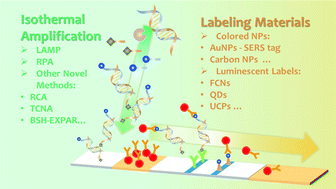Rapid developments in lateral flow immunoassay for nucleic acid detection
Abstract
Recently, lateral flow assay (LFA) for nucleic acid detection has drawn increasing attention in the point-of-care testing fields. Due to its rapidity, easy implementation, and low equipment requirement, it is well suited for use in rapid diagnosis, food authentication, and environmental monitoring under source-limited conditions. This review will discuss two main research directions of lateral flow nucleic acid tests. The first one is the incorporation of isothermal amplification methods with LFA, which ensures an ultra-high testing sensitivity under non-laboratory conditions. The two most commonly used methodologies will be discussed, namely Loop-mediated Isothermal Amplification (LAMP) and Recombinase Polymerase Amplification (RPA), and some novel methods with special properties will also be introduced. The second research direction is the development of novel labeling materials. It endeavors to increase the sensitivity and quantifiability of LFA testing, where signals can be read and analyzed by portable devices. These methods are compared in terms of limits of detection, detection times, and quantifiabilities. It is anticipated that future research on lateral flow nucleic acid tests will focus on the integration of the whole testing process into a microfluidic system and the combination with molecular diagnostic tools such as clustered regularly interspaced short palindromic repeats to facilitate a rapid and accurate test.

- This article is part of the themed collections: Analyst Recent HOT articles and Recent Review Articles


 Please wait while we load your content...
Please wait while we load your content...